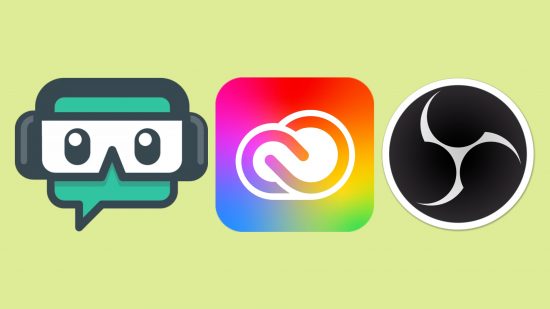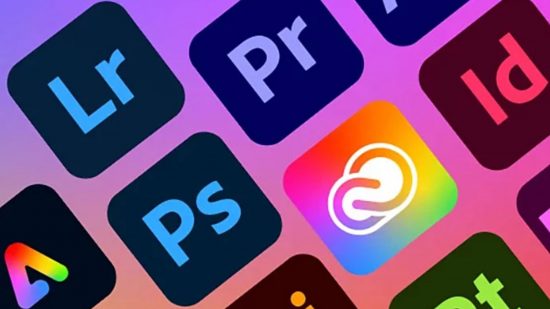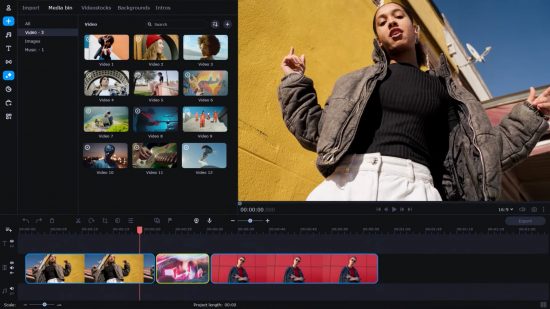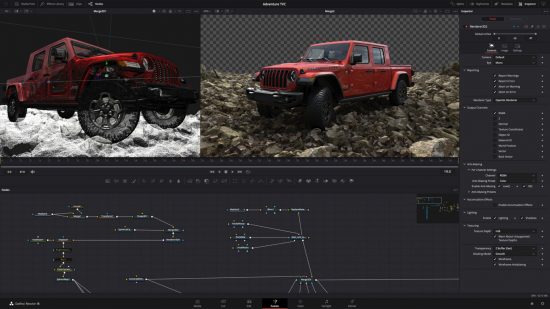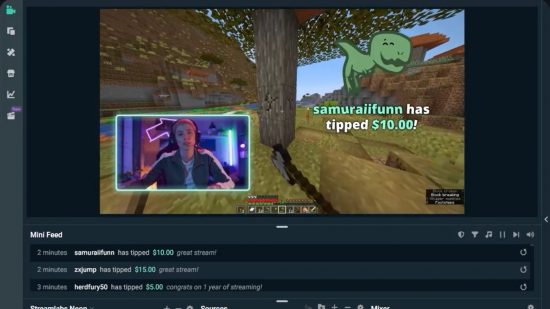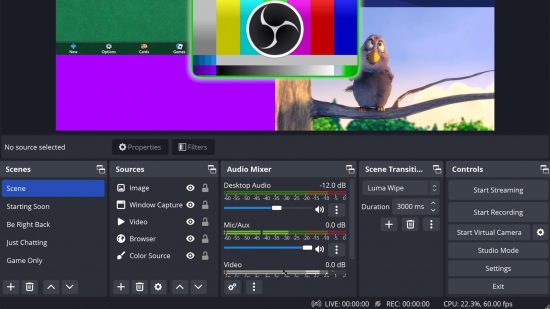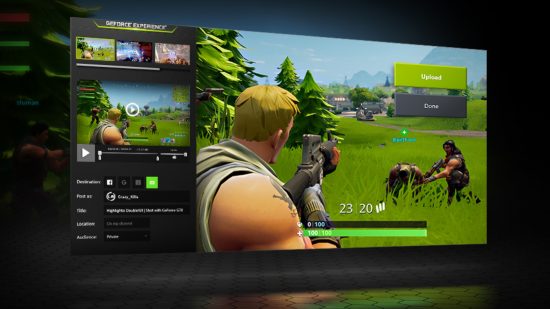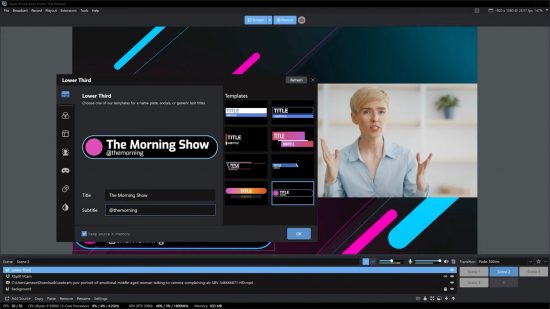What’s the best streaming software? If you want to be a streamer, you’ll need something that converts your content into the right format for platforms like YouTube and Twitch. There are also programs for editing your video footage, which is why we’ve separated this list into two sections.
We’ve picked software options here for every level, including free programs, to help you find what you need at the right price. If you’ve never streamed before, Streamlabs OBS is the best place to start for beginners. If you want truly pro results, OBS Studio is the way to go – but it’s more technical to use. When it comes to editing, we love Adobe’s Photography package, but it’s not the cheapest option.
Of course, it’s important to make sure that you’re using the best streaming lighting and best microphone for streaming, (if you’re a newcomer, here’s what you need to assemble the best streaming setup). But the fanciest light and sound won’t mean anything if you don’t have the stream itself sorted. That’s why we’ve picked out industry-leading recommendations for you, based on what we’ve used ourselves.
Best streaming software for editing in 2024:
- Adobe Creative Cloud – best overall
- Movavi Video Editor – budget choice
- DaVinci Resolve Studio – best with no subscription
1. Adobe Creative Cloud
Best for editing everything.
Adobe Creative Cloud specs:
| Compatible with | Windows, MacOS |
| Multi-camera editing | Yes |
| Payment type | Subscription |
| Free trial | 7 days |
Pros:
- Industry-standard
- Full suite of editing apps
- Extremely robust
Cons:
- Monthly subscription
- Competition catching up
- “Evil empire” syndrome
Much like Vimeo, even if you’ve never streamed before, you’ve probably heard of Adobe – and if you haven’t, you’ll almost certainly have heard of Photoshop, Adobe’s flagship product. Adobe software is the industry standard in the world of editing and creativity for good reason: it’s the best in the business.
One of the co-creators of Photoshop, John Knoll, is the chief creative officer at Industrial Light and Magic, where he won two Oscars and worked on everything from Star Wars and Avatar to Pirates of the Caribbean and The Batman. In fact, 10 of 2023’s Oscar-nominated films used Adobe apps in their production, including Top Gun: Maverick and Everything Everywhere All at Once.
In short, if you’re looking for something to edit your footage (along with your stills, 3D models, and anything else), Adobe has you covered. Specifically, Premiere Pro is a hugely powerful video editor, while After Effects is your go-to for visual effects and motion graphics.
The real drawback of Adobe is its pricing structure. Creative Cloud delivers over 20 apps for a monthly or yearly subscription, and you can pick and choose which you pay for, but you’re obviously locked into paying an ongoing fee to keep using them.
2. Movavi Video Editor
Best budget editing option.
Movavi Video Editor specs:
| Compatible with | Windows, Mac |
| Multi-camera editing | Yes |
| Payment type | One-off, or subscription |
| Free trial | 7 days |
Pros:
- Competitively priced
- Very easy to use
- Good support
Cons:
- Slow rendering
- Curious NAS issue
- Not as powerful as rivals
With the big boys of the video editing scene being pricey powerhouses that require an advanced level of understanding, Movavi set out to deliver something both affordable and easy to use. The result is a video editor packed with impressive features that are simple to implement – though you sacrifice some useful top-end features along with rendering speed.
From motion control to chroma key to transitions, Movavi democratizes a lot of tools that were previously the preserve of advanced editors. There are also some clever AI features, including background removal and motion tracking (although it’s not nearly as sophisticated as Adobe’s frankly spooky AI trickery).
The single biggest thing Movavi has going for it is its pricing structure. How does it compare? Well, with Adobe you’re looking at around 50 bucks a month for Creative Cloud All Apps and 20 bucks for Premier Pro alone, while DaVinci Resolve has a one-time fee of about 250 bucks. So Movavi, at around 50 bucks for an annual sub or 90-odd bucks for life, is a pretty good deal.
Be warned if you use a NAS drive, however; Movavi enables you to edit files located on a NAS drive, but only lets you save your edits on the local drive.
3. DaVinci Resolve Studio
Best for pay-once video editing.
DaVinci Resolve Studio specs:
| Compatible with | Windows 10+, Linux, MacOS 11 Big Sur+ |
| Multi-camera editing | Yes |
| Payment type | One-off |
| Free trial | None, but free plan available |
Pros:
- One-off, lifetime fee
- Free option
- Incredibly powerful
Cons:
- Less popular
- Not as diverse as Adobe
- Can be tricky to learn
Adobe may be the biggest game in town when it comes to editing, but it certainly isn’t the only one. DaVinci Resolve has become the biggest rival to Adobe Premiere Pro, particularly since it was purchased by Blackmagic Design – a high-end cinematography company that makes cameras and equipment for the motion picture industry.
Unsurprisingly, DaVinci Resolve has likewise been used in plenty of blockbusters, including Alien: Covenant, Deadpool 2, Jason Bourne, and Oscar-winners like La La Land. In short, it’s every bit as capable as Adobe’s option – but it’s not every bit as friendly, as it works quite differently.
Where Premiere Pro employs a non-linear timeline for organizing video, audio, and other assets, DaVinci Resolve uses a nodular freeform timeline. Being the industry standard, Premiere’s method is the one that is most familiar and most intuitive (and, thus, most copied by other apps).
DaVinci’s layout is not as immediate or user-friendly, but it’s actually very instinctive once you wrap your brain around it – and it’s incredibly powerful. Where you need to rely on lots of individual Creative Cloud apps with Adobe, here they’re all integrated (such as Fusion for motion graphics and Fairlight for audio). And, rather than an ongoing subscription, it has a one-off purchase price.
Best streaming software: Streams
- Streamlabs OBS – best for beginners
- OBS Studio – advanced choice
- Vimeo – best performance
- Nvidia ShadowPlay – pro-gamer’s choice
- XSplit Broadcaster – freemium option
1. Streamlabs OBS
Best for beginners.
Streamlabs OBS specs:
| Compatible with | Windows, MacOS, Android |
| Audio-mixing | Yes |
| Integrated chat | Yes |
| Included themes | 250 |
Pros:
- Straightforward to use
- Fast to set up
- Offers auto-optimization
Cons:
- Features need subscription
- Windows only
- Can be CPU inefficient
Fittingly, we’ll start with the software that everyone should start with! Not only is Streamlabs OBS free, it’s built on the same open-source code (Open Broadcaster Software) that powers the fan-favorite OBS Studio aimed at more advanced users.
Despite having similar names the two programs are unrelated, though sharing the same core architecture means that you can rely on the same kind of performance as its spiritual sibling – but with a user interface that’s streamlined and better for beginners, and is very much oriented towards gaming.
This really is simple software to use, and very quick to set up, making it easy to stream to Twitch, YouTube, and Facebook with a selection of ready-made overlays. Given that Streamlabs OBS is free, additional overlays and features (such as multistreaming across platforms) can be unlocked by subscribing to Streamlabs Prime.
Aside from that, the only real drawbacks are that the software is only for Windows users and that the additional footage can clog up your system resources. It should also be remembered that the open-source nature means that support comes primarily from the community, and a few bugs and glitches are par for the course.
2. OBS Studio
Best for advanced streaming.
OBS Studio specs:
| Compatible with | Windows, Mac, Linux |
| Audi0-mixing | Yes |
| Integrated chat | No |
| Included Themes | 4 |
Pros:
- Great performance
- Powerful, pro results
- Windows, Mac, Linux
Cons:
- User interface not instinctive
- Very steep learning curve
- Prone to glitching
If you don’t need the training wheels that Streamlabs OBS provides, OBS Studio is without a doubt the best way to go. Again, the shared name doesn’t imply any relation between the two packages – but Studio is the open-source framework upon which Streamlabs was built.
That means you’re looking, again, at an application that’s free to download and use – but where you will be more reliant on the community than on formal user support from the developer. However, its open-source nature is a real credit for advanced users willing to invest time in mastering the software, as the community has created all manner of plug-ins and add-ons to increase the feature set.
Investing time is the key here, as the interface isn’t very intuitive or user-friendly (hence why Streamlabs is the better option for first-timers). Persistence pays off, though, as Studio offers a whole lot of power, versatility, and customizability, enabling you to create content free from the constraints of prescribed templates and overlays.
Capable as it is, you will probably bump your head against glitches in the Matrix thanks to the open-source and slightly ramshackle nature of bolting on components. Once it’s completely configured, though, you’ll never need anything else.
3. Vimeo
Vimeo offers the best performance.
Vimeo specs:
| Compatible with | Windows, MacOS, Android |
| Audio-mixing | Yes |
| Integrated chat | Yes |
| Included themes | None, though you can add graphics |
Pros:
- Robust and reliable
- Unlimited streaming
- White labeling
Cons:
- Expensive
- Slight learning curve
- CPU intensive
If you’re new to the world of streaming, Vimeo may well be the only name on this list that you recognize. Don’t worry, though – this service has got more going for it than just brand recognition. After all, it is one of the leaders in online video for good reason; beyond just the streaming sphere, Vimeo is right up there with YouTube as a content platform, so you’re definitely running with the big dogs.
This comes with a big plus and a big minus. The plus is that, well, it’s Vimeo. Unlike the two OBS-based offerings, this isn’t an open-source platform held together by duck tape and the goodwill of its community; it’s a huge, well-oiled machine with plenty of support, and, everything just plain works.
The minus is that, well, it’s Vimeo. And since it is a huge, well-oiled, well-run machine, it has significantly higher overheads – which are passed onto the user in the form of a steep pricing structure.
There is a cost of entry in terms of usability, too. While it’s not as clunky as OBS Studio, Vimeo still assumes a decent level of knowledge when it comes to online production. Still, for the most robust performance and everything from unlimited streaming to live closed captioning, this is very hard to beat.
4. Nvidia ShadowPlay
Best for pure gaming.
Nvidia ShadowPlay specs:
| Compatible with | Windows 10, Windows 11 |
| Audio-mixing | Yes |
| Integrated chat | No |
| Included themes |
Pros:
- Resource-efficient
- Great capture tools
- Comes with GeForce cards
Cons:
- No frills (no overlays etc)
- Lacks features
- More useful for recording
Nvidia’s approach to streaming software really is the definition of no-nonsense. And, in fact, pretty much ‘no anything else’. ShadowPlay simply streams your gameplay – that’s it. No bells, no whistles, no overlays, just pure gameplay. Which, for some people, is refreshingly straightforward and simple – and obviously a million miles away from the often obnoxious overlays and multi-scene overloads of some broadcasts.
The sparseness of features may put off those looking to make their streams as elaborate as possible, but there are plenty of folks who don’t care about the embellishments – they just want to stream what’s on their screen directly to Twitch, YouTube, and Facebook. And this is perfect for those folks.
Another feather in its cap is that ShadowPlay is extremely resource-efficient. Since it encodes using the GPU – which is fitting, since it comes bundled with GeForce graphics cards – it leaves the CPU pretty much alone for minimal impact on performance (helped, no doubt, by not having to slap assets on top of things).
All said, though, it’s arguably a better piece of capture software than it is a streaming product. If you want to create gameplay GIFs or quickly record the last 30 seconds of action, it’s absolutely perfect. If you want anything more elaborate than gameplay, though, look elsewhere.
5. XSplit Broadcaster
Best freemium option
XSpilt Broadcaster specs:
| Compatible with | Windows 7 and up |
| Audio-mixing | Yes |
| Integrated chat | Yes |
| Included themes | over 300 |
Pros:
- Powerful features
- Highly customizable
- Integrated chroma key
Cons:
- No presets
- Free version limited
- Windows only
Not long ago we would have put Gamecaster on this list – a gaming-specific streaming platform that was once part of the XSplit family, before splintering off to become its own product. Despite becoming a fan favorite, however, Gamescaster sadly shut down in March 2023.
The situation is – well, was – a little like the difference between Streamlabs OBS and OBS Studio, with Gamecaster being a simple and straightforward application aimed at newcomers, with Broadcaster being a more powerful, professional option that users could graduate to.
With the former shutdown, we’re back to recommending XSplit’s more sophisticated all-purpose streaming app. It’s much less simple, but also much more powerful, offering everything from 4K 60p streams and integrated chroma-key (green screen) to multi-broadcasting and stream delay.
Broadcaster is a freemium product, meaning it’s free to download but the more advanced features are unlocked via a monthly or lifetime subscription. So while on the one hand, the interface is friendly and you soon learn how to stream to YouTube, Facebook, and Twitch, limitations (such as watermarks above 720p) quickly start to creep in.
The premium options are pretty good value for money, and the software has a great performance-to-power ratio, but you’ll probably want to explore other options on this list first.
How we chose the best streaming software
There are many factors that go into choosing the best software for streaming. These are the factors we take into account when making out selections:
- Price: Subscriptions make this tricky, but ultimately we’re looking for products that offer great value for money (and free might sound like a great value, but free versions of the software are very limited).
- Features: For more affordable or entry-level software, we want useful features that are easy to implement. For more advanced software, we want powerful features and professional results.
- Ease of use: We’re pretty experienced at using software like this, but not everybody is! Beginner apps need to be straightforward, and advanced apps need to be intuitive.
- Compatibility: Not all packages support all operating systems, but it’s important that as many systems are supported as possible (we love you, Linux!).
- Performance: Streaming is extremely heavy on system resources. Great software is no good if it makes your computer grind to a halt.
- Stability: Nobody wants their software to crash, so we pay close attention to how stable apps are (especially open-source software).
For more information about how we decide what to include in lists like these, check out our how we test page. Our guides on the best streaming set-up for beginners, and the best capture cards for streaming will also be useful points of reference to boost your Twitch career.
